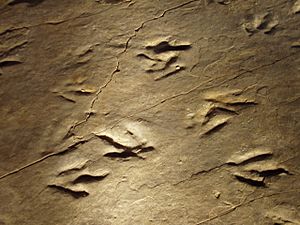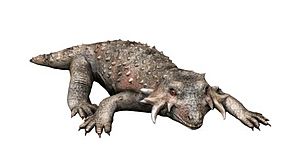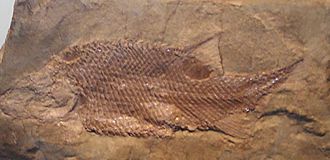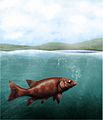List of the prehistoric life of Connecticut facts for kids
Have you ever wondered what kinds of amazing creatures lived in Connecticut long, long ago? This article explores the incredible prehistoric life that once roamed, swam, or grew in what is now Connecticut, based on the fossils found here. These fossils tell us stories about ancient plants and animals, from tiny insects to giant dinosaurs, that lived millions of years before humans existed.
Contents
Connecticut's Ancient Past: No Early Fossils Found
Scientists study fossils to learn about life from the past. For a very long time, during the Precambrian and Paleozoic eras, there are no known fossils found in Connecticut. This means that either no life existed there yet, or conditions were not right for fossils to form and be preserved. Most of Connecticut's famous fossils come from a later time.
Mesozoic Era: The Age of Dinosaurs in Connecticut
The Mesozoic Era, often called the "Age of Dinosaurs," is when Connecticut truly comes alive with prehistoric finds. Many amazing fossils from this time have been discovered across the state. These include bones, plant remains, and even dinosaur footprints!
Dinosaurs and Their Footprints
Connecticut is famous for its dinosaur footprints. These tracks are like ancient clues left behind by dinosaurs walking through soft mud that later turned into rock.
-
Fossil Eubrontes tracks. Eubrontes is the Connecticut state fossil.
* Eubrontes: This is the official state fossil of Connecticut! Eubrontes are large, three-toed footprints likely made by a meat-eating dinosaur similar to Dilophosaurus. Many Eubrontes tracks can be seen at Dinosaur State Park and Arboretum in Rocky Hill. * Anchisauripus: These footprints are also from three-toed dinosaurs, but they are generally smaller than Eubrontes. They were probably made by medium-sized meat-eaters. * Grallator: These are smaller, bird-like dinosaur footprints. They show that even smaller dinosaurs roamed ancient Connecticut.
* Otozoum:
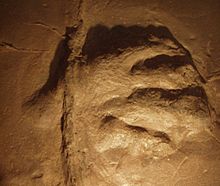
These large, five-toed footprints were likely made by early long-necked, plant-eating dinosaurs called sauropodomorphs.
* Brontozoum: Another type of large footprint, possibly from a sauropodomorph dinosaur.
Actual Dinosaur Bones Found
While footprints are common, finding actual dinosaur bones is rarer in Connecticut.
- Anchisaurus:
This was an early sauropodomorph dinosaur. It was smaller than the giant long-necked dinosaurs that came later, but still a significant find. Its bones have been found in Connecticut.
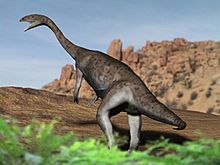 Restoration of the Early Jurassic sauropodomorph dinosaur Anchisaurus
Restoration of the Early Jurassic sauropodomorph dinosaur Anchisaurus - Coelophysis: This was a slender, fast-moving meat-eating dinosaur. Fossils of Coelophysis have also been reported from Connecticut.
Other Ancient Reptiles
Dinosaurs weren't the only reptiles around!
- Hypsognathus: This was a small, plant-eating reptile that looked a bit like a lizard. It lived during the Late Triassic period.
- Belodon: This was a type of phytosaur, a crocodile-like reptile that lived in the water. They were top predators in their ancient environments.
- Erpetosuchus: This was another crocodile-like reptile, but it lived on land.
Fish from Ancient Lakes
During the Mesozoic Era, Connecticut had large lakes where fish thrived.
- Semionotus: This was a common type of bony fish that lived in freshwater lakes. Many well-preserved Semionotus fossils have been found in Connecticut.
- Redfieldius: Another type of ancient bony fish found in the same freshwater environments as Semionotus.
Prehistoric Plants
Plants are also a crucial part of the fossil record, showing us what the ancient landscape looked like.
- Baiera: This was a type of ancient plant related to modern ginkgo trees.
- Botryopera: Another plant fossil found, helping scientists understand the ancient flora.
Other Trace Fossils (Not Bones or Plants)
Besides footprints, other "trace fossils" show signs of ancient life.
- Acanthichnus: These are trace fossils that might be tracks or trails left by ancient invertebrates.
- Cochlichnus: These are wavy trails, likely made by worms or other soft-bodied creatures moving through sediment.
- Mormolucoides: These are also trace fossils, possibly from insect larvae or other small creatures.
Cenozoic Era: More Recent Times
Just like the earliest eras, there are no known fossils from the Cenozoic Era found in Connecticut. This era includes the time after the dinosaurs died out, leading up to today. This means that while Connecticut has a rich dinosaur history, evidence of mammals and other modern-looking animals from the Cenozoic is not typically found here.
Images for kids


